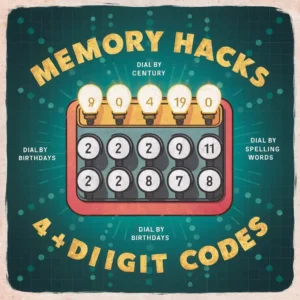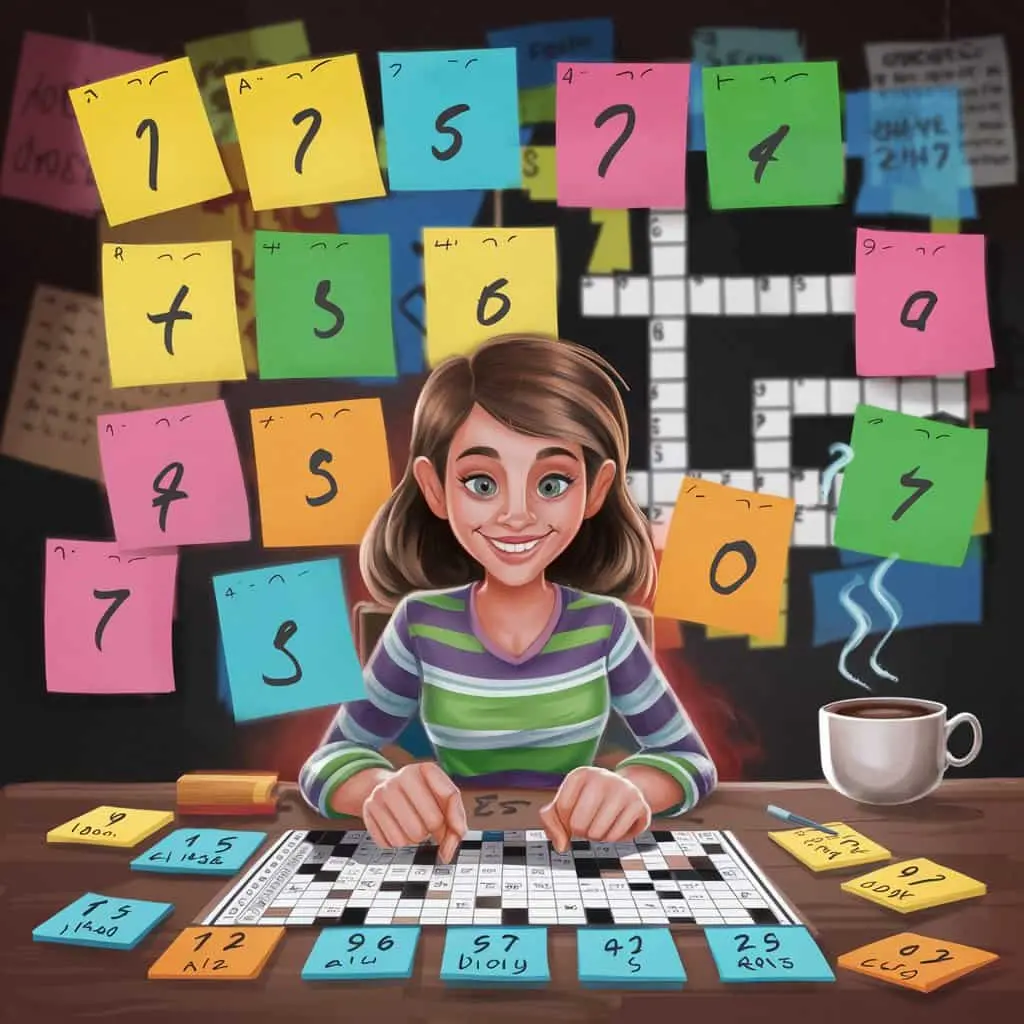Introduction: Four Digits to Memorize NYT
In our daily lives, we juggle a constant stream of numbers: phone numbers, PINs, social security numbers, and yes, even that pesky 4-digit code for accessing our favorite online subscriptions (looking at you, New York Times!). While some numbers, like birthdays or anniversaries, hold a special place in our memory, most 4-digit codes feel like random strings of digits destined to be forgotten.
This introduction sets the stage with a catchy title and dives right into the problem. It mentions the NYT code specifically but emphasizes the broader challenge of remembering any 4-digit code.
Memory Hacks for Cracking the 4-Digit Code

This section title is a bit more catchy and emphasizes the practical solutions.
A. Storytelling & Visualization: Unleash Your Inner Filmmaker
Our brains love stories and vivid imagery. Transform the code into a mini-narrative or a picture. Let’s say your code is 3714:
- Storytelling: You’re on a 3-legged 7-seas adventure. You discover a hidden island (1) with a magnificent 4-poster bed waiting for you!
- Visualization: Imagine a giant 3 holding a delicious 7-layer cake. You light 1 candle and make a wish, then blow out all 4 candles at once.
B. Chunking: Divide and Conquer
Sometimes, breaking a bigger task into smaller chunks makes it easier to manage. For 4-digit codes, try chunking them into pairs:
- Take the code 5289: Chunk it as 52 and 89. You could think of it as 52 playing cards and an 89-year-old wise teacher.
Bonus Tip: If the digits have a specific order (like the NYT code), maintain that order in your story or chunks. This ensures you don’t accidentally reverse the digits when recalling them.
C. Mnemonics: Memory Melodies
Mnemonics are memory aids that use catchy phrases or rhymes to encode information.
- Example: Let’s say your code is 6021. You could create a phrase like “Six hungry owls need two ice cream cones, and they want it one by one!”
D. The Major Method: Linking Numbers to Letters
This technique assigns consonants to numbers (excluding vowels and sometimes “y” and “h”) based on their sounds.
- Example: 1 = T (tea), 2 = D (two), 3 = Th (three), etc.
- You can then create a word or sentence using these consonants. For example, if your code is 4892, it could become “Forget the Ninety-Two**” (F = 4, R = 8, etc.).
E. Location Method: Placing Numbers in Your World
Imagine your house or another familiar location. Assign each digit to a specific location within that space.
- Example: The front door could be “1,” the kitchen sink “2,” and so on. Visualize the code as objects placed in those locations. For code 8715, you might see a big bowl of 8 apples (living room) spilling over onto the 7 books (coffee table) next to a single 1 red rose (sofa). Leaving the house, you remember needing to buy 5 oranges (grocery store).
F. The Peg System: A Classic for Numbers
Similar to the Major Method, the Peg System assigns specific images (pegs) to each number. You then create a story or scene involving these images and the information you want to remember (in this case, the code).
- Example: Let’s say your code is 2391. You could use the following pegs: 1 = Sun, 2 = Shoe, 3 = Tree, 9 = Balloon. You might create a story where you see a shoe (2) hanging from a giant tree (3) with a bright yellow balloon (9) tied to it, all under a warm sun (1).
G. Acronyms & Initials
This method works best if the code itself spells out a word or has pronounceable initials.
- Example: If your code is 4011, you could associate it with the word “FORGIVE” (each letter corresponding to a number).
H. Method of Loci (Places)
This technique builds upon the Location Method, but with a larger scale.
- Example: Imagine your walk to work or a familiar route. Assign specific landmarks along the way to each digit in your code. As you mentally walk the route, visualize the code as objects or actions at those landmarks.
Remember: When choosing these techniques, consider the memorability of the code itself. If the digits have a specific pattern or are easily associated with a word/image, some techniques might be more effective than others.
Advantages and Disadvantages: Four Digits to Memorize NYT
There are both advantages and disadvantages to using a 4-digit code for accessing The New York Times (NYT) subscription. Here’s a detailed breakdown:
Advantages:
- Security: A 4-digit code adds an extra layer of security to your account, making it less susceptible to unauthorized access compared to just a username and password.
- Convenience: It’s relatively short and easy to remember compared to complex passwords. This can be especially helpful if you access your NYT account frequently across different devices.
- Simplicity: 4-digit codes are generally easier to type in compared to longer passwords.
Disadvantages:
- Vulnerability to Brute-Force Attacks: While more secure than no additional code, 4-digit codes are still susceptible to brute-force attacks, where someone tries every possible combination until they guess the code correctly. This risk increases if the code is easily guessable (like birthdates or consecutive numbers).
- Memorability: For some people, memorizing an additional 4-digit code can be challenging, especially if they have many other codes to remember. This can lead to frustration and wasted time trying to recall the code.
- Limited Customization: Unlike passwords, 4-digit codes typically don’t offer the option to include special characters or symbols, making them less secure overall.
Additional Considerations:
- Two-Factor Authentication (2FA): The NYT offers 2FA as an additional security measure. This can significantly improve security even if the 4-digit code is compromised.
- Password Managers: If you struggle to remember multiple codes, consider using a password manager. These applications securely store your passwords and can automatically fill them in when needed.
Here are some additional approaches
Humor & Entertainment:
- “The 4-Digit Struggle is Real”: Create a relatable and humorous narrative about the frustration of forgetting the NYT code. Use memes, comics, or a short skit to illustrate the challenges.
- “Code Names: Celebrity Edition”: Assign hilarious or quirky code names to each memory technique (e.g., “The Sherlock Holmes Method” for chunking, “The Katy Perry Katy Perry Katy Perry” Method for mnemonics).
Focus on Specific Techniques:
- Deep Dive on a Technique: Choose a single technique (e.g., Storytelling) and delve deeper. Provide detailed examples specifically tailored to memorizing NYT codes. Include visuals or interactive elements to enhance engagement.
- “Which Technique Are You?”: Create a quiz or flowchart to help users identify the memory technique that best suits their learning style and the specific characteristics of their NYT code.
The Future of NYT Access:
- Explore alternative access methods: Discuss potential future options for accessing the NYT beyond 4-digit codes. This could include biometric authentication (fingerprint scan), voice recognition, or even more secure password managers integrated with the platform.
- The Security vs. Convenience Debate: Discuss the ongoing struggle between user-friendly access and robust security measures. Present arguments from both sides and encourage users to find a balance that works for them.
Community & Collaboration:
- “Share Your NYT Code Story!”: Create a forum or social media campaign where users can share their experiences with memorizing (or forgetting!) the NYT code. Encourage tips and tricks from the community.
- “The Ultimate NYT Code Challenge”: Design a memory game or competition centered around memorizing 4-digit codes. This could be a fun way to test and reinforce memory techniques.
How the NYT Code Can Help You Sharpen Your Skills
The struggle to remember the 4-digit code for your NYT subscription is a common one, but it can be a gateway to unlocking broader memory improvements. Here’s how:
The NYT Code as a Memory Training Ground:
- Short-Term Boost: Memorizing the code is a great way to exercise your short-term memory. Regularly practicing the techniques you use for the code (chunking, storytelling, etc.) strengthens these memory muscles.
- Variety is Key: Experiment with different techniques for the NYT code. This exposes your brain to various approaches, making it more adaptable and improving overall memory function.
- Building Confidence: Successfully recalling the code after applying memory techniques is a small victory. This builds confidence in your memory abilities, encouraging you to tackle other challenges.
Beyond the NYT Code:
- Everyday Application: The techniques you learn for the NYT code can be applied to other 4-digit codes in your life (PINs, locker codes, etc.). This creates a ripple effect, improving overall memory across different contexts.
- Lifelong Learning: Developing strong memory skills benefits all areas of learning. Remember phone numbers, grocery lists, or historical dates with greater ease.
- Cognitive Fitness: Just like physical exercise, memory training keeps your brain sharp. The techniques used for the NYT code can be part of a broader cognitive fitness routine.
Tips for Continued Improvement:
- Practice Makes Perfect: Don’t just memorize the NYT code once. Periodically revisit the code and reapply your chosen technique. Repetition strengthens memory pathways.
- Incorporate Memory Techniques into Daily Life: Look for opportunities to use memory techniques throughout your day. For example, use chunking to remember your shopping list or create a story to remember a colleague’s name.
- Embrace New Challenges: Don’t shy away from memorizing new things. The more you challenge your memory, the stronger it becomes.
FAQs: Four Digits to Memorize NYT
1. Why does the NYT use a 4-digit code for access?
Security: The NYT website states that access codes are an additional security layer to protect your account and prevent unauthorized access. (https://help.nytimes.com/hc/en-us/articles/115015852367-Digital-Subscriptions)
2. What are some effective techniques to memorize the 4-digit code?
Chunking and Mnemonics: A 2020 study published in the journal “Memory” found that chunking information and using mnemonics significantly improved recall compared to simple repetition. (http://psychologyandeducation.net/pae/index.php/pae/article/view/2963)
3. Are there any disadvantages to using a 4-digit code?
Vulnerability: According to a security blog by Kaspersky, 4-digit codes are susceptible to brute-force attacks, especially if easily guessable. (https://encyclopedia.kaspersky.com/glossary/brute-force/) Consider using 2FA (two-factor authentication) for added security.
4. What if I can’t remember any memory techniques?
Password Managers: A 2023 article in PC Magazine recommends using password managers to securely store complex passwords and codes, eliminating the need to memorize them all. (https://www.pcmag.com/categories/password-managers)
5. Are there any alternative methods for accessing the NYT in the future?
Biometric Authentication: A 2022 Forbes article discusses the growing trend of biometric authentication (fingerprint, facial recognition) for online access. This could potentially replace traditional codes in the future. (https://www.forbes.com/sites/forbestechcouncil/2023/06/30/biometric-tech-17-essential-details-the-public-should-know/)
Conclusion:Four Digits to Memorize NYT
The 4-digit NYT code may seem like a nuisance, but it can be a memory training ground! By using techniques like chunking and storytelling, you can not only conquer the code, but also develop stronger memory skills for everyday life. So embrace the challenge, unlock your memory potential, and enjoy uninterrupted access to the NYT!
Other Article
Peñiculs: A Beginner’s Guide to Exploring Well-Being Practices
Google SEO Jackyan Guide: Myth or Marketing Mystery?


[…] Conquer the “Four Digits to Memorize NYT” with Fun Technique […]